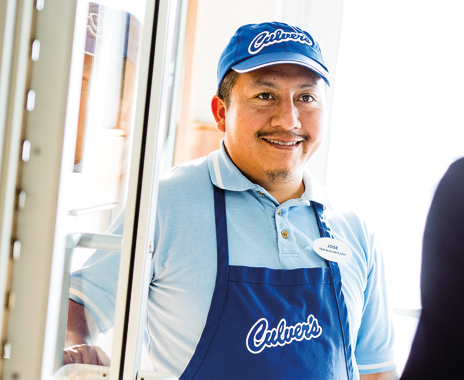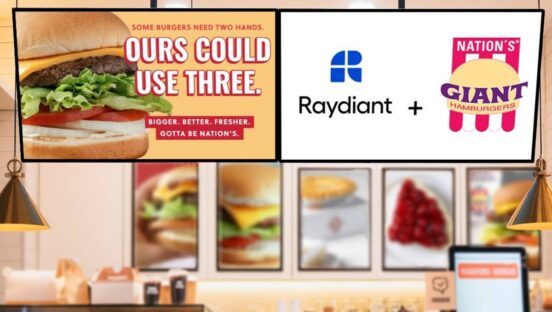It’s mid-September and Thom Crosby is on the road again. Every six months, Crosby, the CEO of Pal’s Sudden Service, a 26-unit chain with stores across Tennessee and Virginia, joins Pal’s founder Fred Barger for a road trip. The pair visit all 26 stores, leading quality and system audits at each stop.
“Everything from speed of service to friendliness at the window,” Crosby says.
Upon a visit’s completion, each store receives its tally, a mark then distributed to every other store in the Pal’s system. Crosby calls the in-store audits an essential piece of Pal’s heralded customer service program and one of the many drivers fueling the company’s longstanding mission to delight every customer in a way that creates loyalty.
“There are lots of restaurants producing good products and doing so with great customer service, but we feel we have to be at the top of the heap and have our customer service be a key differentiator between us and the competition,” Crosby says.
While Crosby says restaurants might be able to buy customers with big deals or free offerings, or corral traffic with unique flavor profiles, it’s customer service that he believes brings the most power to the marketplace.
“It’s customer service that will help people relate to the brand,” says Crosby, whose company also runs the Pal’s Business Excellence Institute, a training ground for other hospitality companies to learn about more effective customer service.
But winning at customer service is no easy feat in today’s quick-service landscape, one featuring ultra-discerning customers, social media’s looming shadow, and diverse touchpoints, from the in-store counter and drive-thru window to mobile ordering, catering, and delivery. Restaurants that hit the customer service home run, however—supplying guests an appealing product, quickly, accurately, and with a smiling face in a clean environment—can position themselves to win traffic, sales, and loyalty in a competitive industry.
“If you’re able to set yourself apart [with strong customer service], people tend to notice,” says Jamie Cohen, chief branding officer at Jason’s Deli, which joined the likes of Chick-fil-A, Whataburger, and Culver’s in Consumer Reports’ 2014 list of quick serves with the best service.
A privately held company with 250 units, Jason’s Deli is manic about customer service, Cohen says.
“We don’t have private equity, Wall Street money, or a well of public money at our disposal, so if customers stop spending money with us, we’ll struggle to grow the brand,” Cohen says. “Truth be told, we’re scared to death to lose a customer.”
While not every chain will be motivated by fear—though fear is indeed a fine motivator in many cases—quick serves with the most successful customer service programs generally share five similar ingredients.
A customer-first culture
At Culver’s, customer service is ingrained in the company’s DNA. Even as the Wisconsin-based chain has expanded to more than 520 units and brought more franchisees into the fold, the burger concept’s unrelenting commitment to customer service remains intact, even at a seemingly granular level such as company vocabulary. For instance, Culver’s eschews the word transaction for guest experience, swaps customers for guests, and instructs its team members to say “My pleasure” rather than “No problem.” Though subtle—some might argue trivial—changes, the precise vocabulary underscores the strict hospitality focus weaving throughout the company’s culture.
“Hospitality drove our success at the start, and it’s been a mainstay with us for the last 30 years,” Culver’s vice president of training George Kelsey says.
While Kelsey readily acknowledges that Culver’s has opportunities to improve, he says the chain has not lost sight of its core values and the customer-first focus that has fueled its success.
“With some early success, I think many restaurants make the mistake of pushing into too many different directions, and the core elements that prompted their initial success deteriorate,” Kelsey says. “That’s not a mistake we are going to make.”
Cheryl Miller, director of client engagement at InMoment, a provider of customer experience surveys and enterprise feedback management, says a robust customer service program always begins with company hierarchy. When company leaders value customer service and commit themselves to arming staff with the tools and insights to put the customer first, then the restaurant flourishes.
“Everyone in the brand has responsibility in the guest experience … and the brands with the best customer service programs understand and embrace this,” she says.
Cohen says restaurant chains cannot systemize or automate their way to culture. Among all employees, he says, there must be the set expectation to make every customer happy. Jason’s Deli spotlights this message during quarterly workshops with its store managers, franchisees, and even vendors, as well as at weekly store-level meetings addressing different hospitality issues or customer touchpoints.
“Throughout the system, our team is prepared,” Cohen says. “We don’t look at this as an extra investment, but rather who we are and what we stand for.”
With the right culture in place, it’s then about operationalizing customer service, a particularly challenging feat as a brand grows, reaches into new markets, or begins franchising.
Strategic hiring
Some restaurants hire bodies to complete tasks. Brands like Culver’s, Pal’s, and Jason’s Deli, however, hire happy people above all else.
Jason’s Deli, for instance, uses a detailed hiring system that includes assessments for friendliness, hospitality, and integrity. That investment underscores the old adage that employers should hire for personality and train for skill.
“Most people can be taught the technical side, but it’s tough to train people to be happy,” Culver’s Kelsey says.
Culver’s instructs its franchisees on the importance of hiring personable staff and specifically advises them to look for candidates that smile, even in positions that do not require direct customer contact. “That first impression leaves a lasting impression and, ultimately, we believe happy team members mean happy guests,” Kelsey says.
With personable employees in the fold, Pal’s focuses on putting each staff member in a position to maximize their strengths. The company uses a 60-question attitude survey to help management better understand where a specific team member best fits in the restaurant.
“It’s not only about getting the right people on the bus, but then getting them in the right seats,” Crosby says.
Comprehensive training programs
At Culver’s, training runs deep. This past summer, 1,500 managers attended classes at ButterBurger University, Culver’s internal training ground in which managers learn various ways to enhance operations. New franchisees, meanwhile, endure a 16-week training program, which includes 12 weeks at one of the Culver family’s units. There, incoming operators observe the hospitality culture on which the Culver’s name has been built.
“We believe we’ve created a powerful concept, but recognize that our long-term success is dependent on the franchisees buying in,” Kelsey says. “That’s why we believe this exposure is so critical. They get to see where we started.”
In addition, the company requires electronic learning courses for all team members, while the majority of Culver’s restaurants also have on-site training coordinators. A consistent message across all training platforms is that even if employees are filling a seemingly mechanical job, such as working the grill, every restaurant team member plays a role in guest satisfaction.
“We try to help our team members understand that they’re not just building a widget, but they’re creating something tangible for our guests,” Kelsey says. “Their success is critical to our success.”
[pagebreak]
In structuring and deploying its training, Pal’s focuses on more than simply the mechanical steps of building recipes or interacting with the customer. Crosby calls it “answering the why.”
“We think it’s imperative our team understands why they’re doing what they’re doing and how it fits into a bigger picture,” Crosby says.
In fact, the training focus at Pal’s is not on graduation, but rather certification. To receive certification from Pal’s as a customer service expert, for instance, employees must pass a test on the material and demonstrate consistent results in the field, such as never stepping away from a customer contact point without being relieved by another team member and maintaining eye contact with customers.
“We’re obsessed with training, not just simply graduating people through our systems, and that intense focus delivers the hospitality we strive for,” Crosby says.
Pal’s leaders also have a practice of never walking by something that’s off standard, while team members are empowered and encouraged to let managers know if something is amiss. “We’ve tuned up our culture to the point that once an employee gets into our system, there’s no deviation from the training and every employee throughout the restaurant knows the standards,” Crosby says. “That keeps everybody on point.”
Systems, processes, and performance
Looking at the totality of the guest experience, savvy quick serves recognize how they can be faster, more accurate, and more engaging.
Too often in the quick-service world, InMoment’s Miller says, the transaction has been reinforced, while hospitality, which includes pleasant attitudes and a desire to serve, fades into the background. “Many interactions with guests might last 30–60 seconds, but we need to deliver a hospitable experience that is genuine, real, and accurate even in that short window of time,” she says.
Miller calls accuracy—providing guests precisely what they ordered and paid for—a major sticking point in the quick-service space, and a complicated one at that, given how many customers leave the premises via drive thru and takeout. An inaccurate order can be a time-sucking, inconvenient, and potentially irreversible mess.
“There are so many things guests will forgive, but sometimes there’s no coming back from an inaccurate order,” Miller says.
Knowing that, Pal’s has long rejected the traditional drive-thru model with speakers. Guests drive right up to the window and order face to face. At the drive thru or the counter, Pal’s order takers then repeat every order back to the customer in a clear voice and watch for visual cues signaling a disconnect.
“If our order takers sense something is wrong, they then stop and clarify,” says Crosby, noting that only one out of every 3,700 Pal’s orders is inaccurate.
Jason’s Deli, meanwhile, looks for those little opportunities to institute something that will make guests’ visits more pleasurable and convenient. Its salad bar kiosks, for instance, allow guests entering a crowded restaurant to bypass the line and create the experience they want. Stores also offer free ice cream to guests. “Those are the little things that set us apart,” Cohen says.
Listening to customers, recognizing employees
Collecting guest feedback plays a key role in driving customer service, the experts say, especially when brands share that data with staff.
“For many employees, hearing the customer’s voice hits home,” Miller says.
In addition to providing the results of its in-store audits to all staff, Pal’s posts the quantifiable data InMoment collects for the company on performance in key areas, such as accuracy, quality, and overall satisfaction.
“It’s not fun to play the game if you don’t know the score,” Crosby says, adding that each Pal’s store then “recalibrates” on a quarterly basis by identifying individuals who might need to be retrained or recertified in particular areas.
Too often, however, Crosby feels restaurants take a narrow view of metrics. They focus so tightly on speed that they sacrifice quality or choose to engage customers more and, as a result, frustrate convenience-craving customers. Crosby also believes that companies need to celebrate their superstars. He estimates that 80–85 percent of Pal’s structured coaching process falls on the side of positive enforcement. Ultimately, he says, people want employers to value and appreciate their efforts, and acknowledging strong work on a daily basis ripples throughout the restaurant, he says.
Similarly, Jason’s Deli believes in recognizing high-quality work. Chief of corporate operations Wade Sterns frequently sends notes to front-line employees who have made a positive impression on a customer. “We believe highly in recognizing people, and we want our team members to feel that their job matters,” Cohen says.











